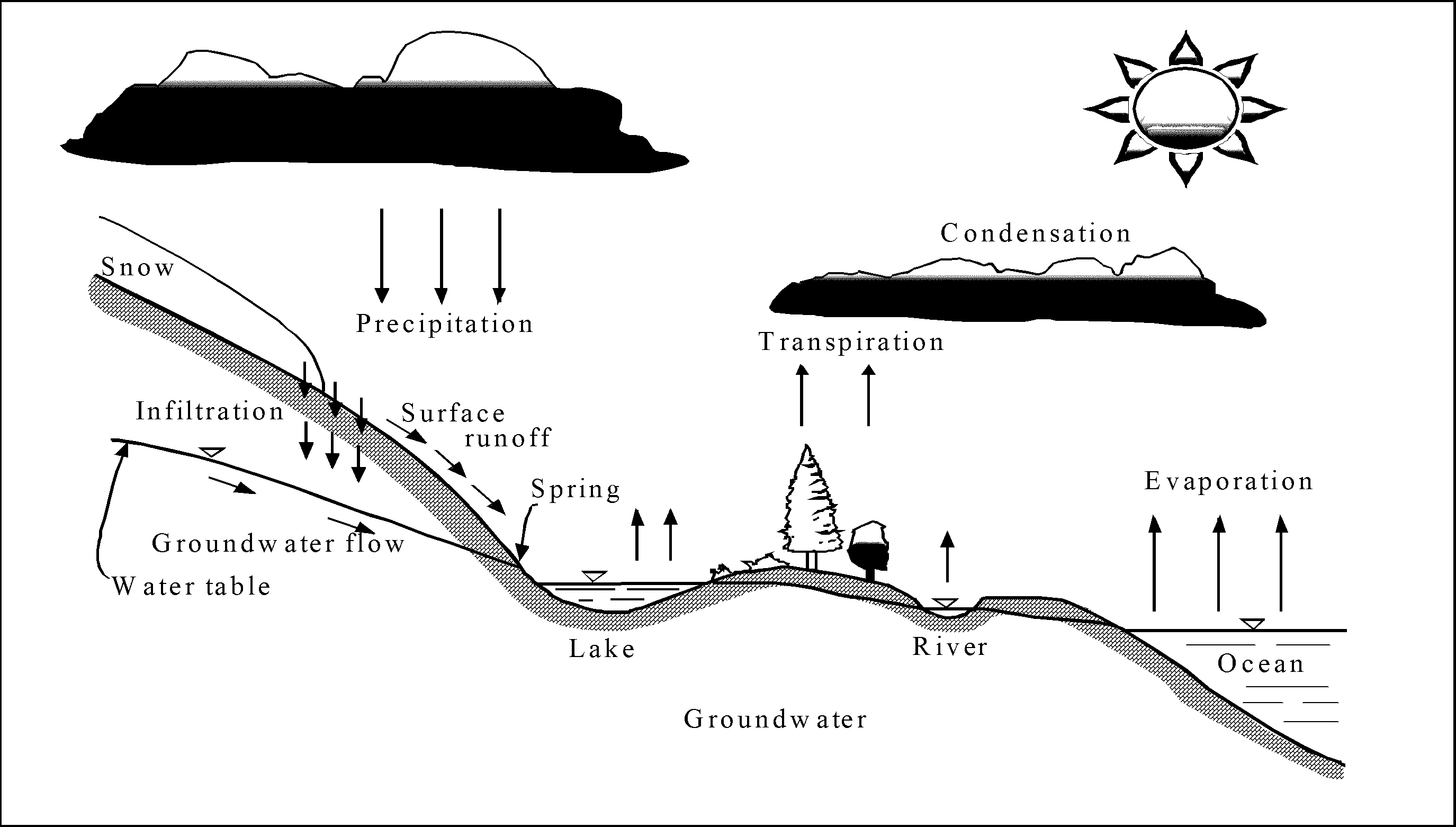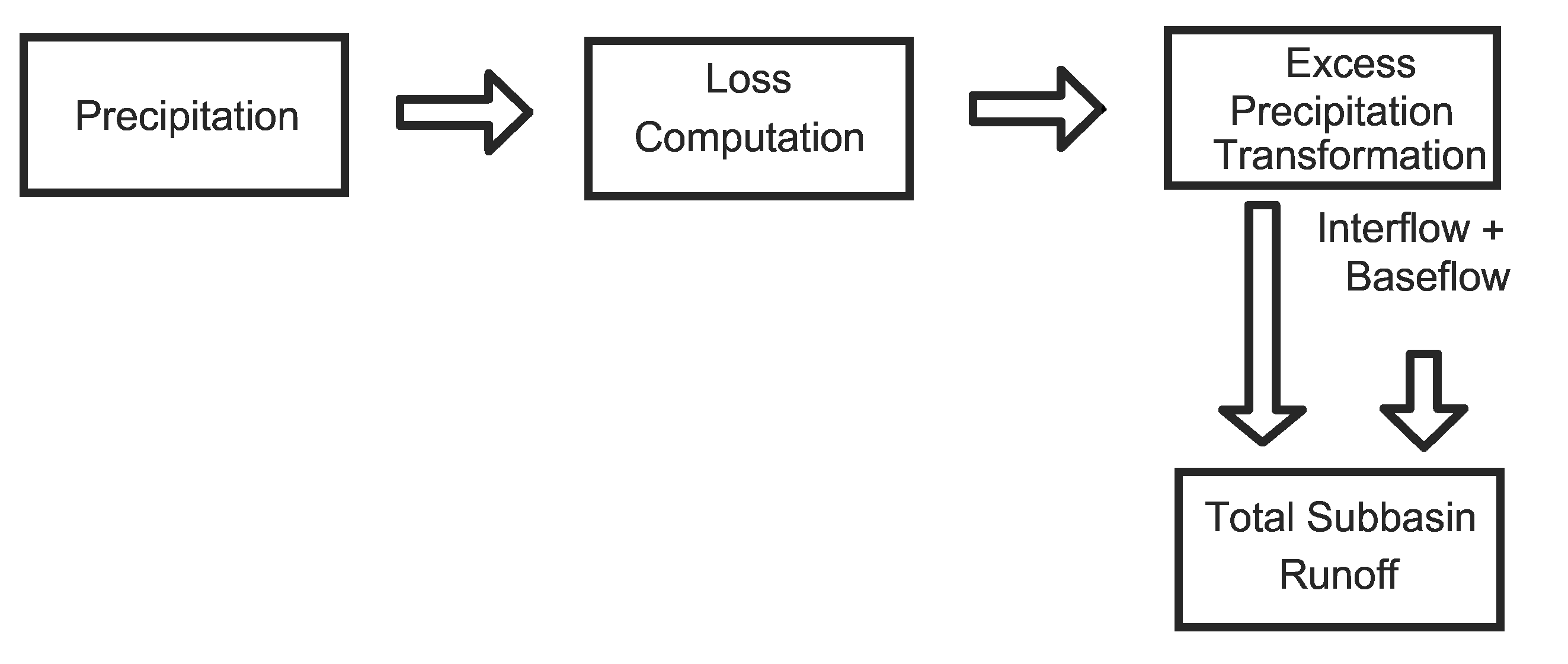
Welcome to CivilGEO Knowledge Base
Welcome to CivilGEO Knowledge Base

Welcome to CivilGEO Knowledge Base
Welcome to CivilGEO Knowledge Base
Hydrology is the science that encompasses the occurrence, distribution, movement, and properties of the earth’s waters and their relationship with the environment within each phase of the hydrologic cycle. The hydrologic cycle is a continuous process by which water is purified by evaporation and transported from the earth’s surface (including the oceans) to the atmosphere and back to the land and oceans.

The hydrologic cycle is divided into logical phases or processes and is incorporated in the HEC-HMS software. These processes are simulated to varying levels of detail and work together to estimate the total runoff from a subbasin.
HEC-HMS calculates the total subbasin runoff by computing the volume of water that is intercepted, infiltrated, stored, evaporated, or transpired and subtracting it from the precipitation. This article describes various hydrology methods that are used within HEC-HMS to compute total runoff from a subbasin.
Total runoff from a subbasin is computed by subtracting precipitation loss, transforming excess precipitation (direct-runoff), and adding baseflow. In addition, a canopy component and a surface component can be included in the computations. The canopy component accounts for the precipitation loss due to interception by vegetation and evapotranspiration. The surface component accounts for water caught in surface depressional storage.

HEC-HMS includes multiple methods to model physical runoff processes where the user selects an appropriate method based on data availability and requirements. Different methodologies are available to estimate infiltration losses, canopy, and surface interception, transform excess precipitation into surface runoff, and calculate baseflow contributions to subbasin runoff.
Infiltration represents the movement of water to areas beneath the land surface. Infiltration methods are used to calculate precipitation loss due to infiltration. It is impossible to precisely predict infiltration in heterogeneous soil over commonly used modeling scales, such as hundreds to thousands of square miles. Thus, many simplifications were made over time to calculate a near accurate rate of infiltration; Several infiltration methods are available to calculate infiltration losses.
Refer to this article in our knowledge base to learn about various infiltration methods and how to use them to compute surface runoff.
Runoff (Transform) methods are used to transform the excess precipitation (after the losses have been subtracted) into surface runoff (direct-runoff). HEC-HMS provides two types of transform methods:
Refer to this article in our knowledge base to learn about various runoff methods and how to use them to compute surface runoff.
Baseflow methods are used to represent contributions to subbasin runoff due to excess groundwater. Baseflow is comprised of runoff that infiltrates into the ground, flows down gradient or slope, and then reaches back on the land surface and flows back into small channels. The smaller channels merge in a larger channel, then into the stream and river and so on.
Baseflow comprises mainly two components: Interflow and Baseflow (saturated ground water). Interflow is the water that travels in the unsaturated portion of the soil down gradient and then at some point comes back onto the land surface to merge in small streams or channels. Baseflow is the water that percolates into the groundwater and then from the groundwater contributes to channel flow at some point.
Conceptual and process-based methods, also known as physically based methods, are available to model baseflow. HEC-HMS includes only conceptual methods, which means that the model in use should be calibrated accordingly when using any baseflow methods.
Refer to this article in our knowledge base to learn about various baseflow methods and how to use them to compute surface runoff.
Surface storage methods are used to compute precipitation losses due to local depressions in the ground surface, cracks and crevices in parking lots or roofs. The surface component is included to represent the ground surface where water may accumulate in surface depression storage.
Selecting a surface method is optional and generally only used for continuous simulation applications. If no surface storage method is selected, the subbasin will not compute losses due to depression storage, and all precipitation will be treated as direct runoff subject to canopy interception and soil infiltration.
Refer to this article in our knowledge base to learn about various surface storage methods and how to use them to compute surface runoff.
The canopy component represents the presence of plants in the landscape. Plants intercept precipitation, reducing the amount of precipitation that arrives at the ground surface. Intercepted water evaporates between storm events. Plants also extract water from the soil in a process called transpiration. Evaporation and transpiration are often combined as evapotranspiration. Canopy methods are used to account for precipitation loss due to evapotranspiration.
Selecting a canopy method is optional but should be used for continuous simulation applications. If no canopy method is selected, the subbasin will not compute any losses due to evapotranspiration and all precipitation will be treated as direct precipitation.
Refer to this article in our knowledge base to learn about various canopy methods and how to use them to compute surface runoff.
 1-800-301-02-955
1-800-301-02-955
 608-729-5100
608-729-5100
(US and Canada)
 [email protected]
[email protected]
 +1 608-729-5100
+1 608-729-5100
CivilGEO India
Graphix Tower, A-13 A
3rd Floor, Sector 62
Noida, Uttar Pradesh 201309
IndiaTel:
1-800-301-02-955 or
+91 022-3831-8601
CivilGEO United States
8383 Greenway Blvd
6th Floor
Middleton, WI 53562
USATel:
608-729-5100 or
800-488-4110
Copyright © CivilGEO, Inc. All rights reserved. The CivilGEO logo, “GeoSTORM”, “GeoHECHMS”, “GeoHECRAS”, and “Ready To Engineer” are registered trademarks of CivilGEO,Inc.
All other brands, company names, product names or trademarks belong to their respective holders.
We use cookies to give you the best online experience. By agreeing you accept the use of cookies in accordance with our cookie policy.
When you visit any web site, it may store or retrieve information on your browser, mostly in the form of cookies. Control your personal Cookie Services here.
The ZoomInfo WebSights snippet drops three cookies to track Unique Visits:
1. _pxhd - Related to the Perimeter X security layer (Perimeter X isused to prevent bot attacks).
2. _cfduid - Related to the CloudFlare security layer (CloudFlare is the Network Security protocol that ZoomInfo uses to orchestrate the rate limiting rules).
3. visitorId - This is how WebSights identifies recurring visitors








